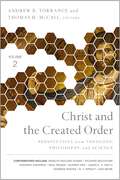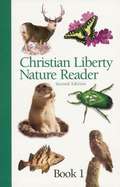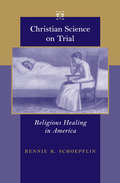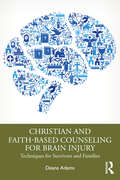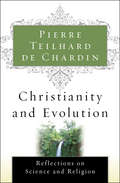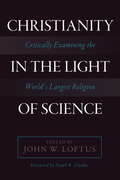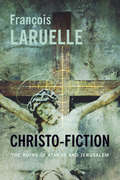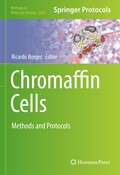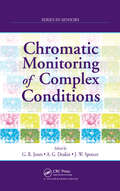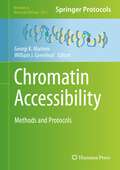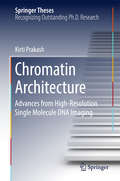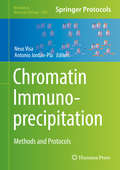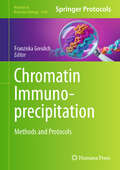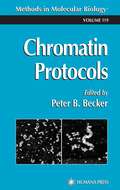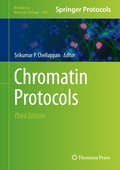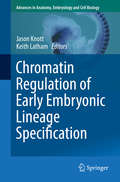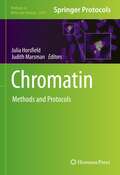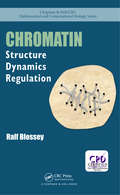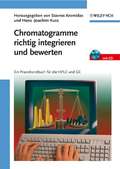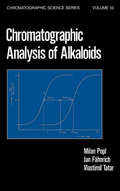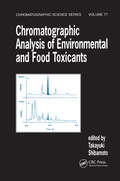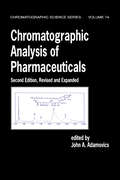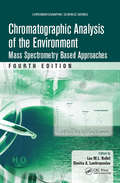- Table View
- List View
Christ and the Created Order: Perspectives from Theology, Philosophy, and Science
by Thomas H. McCall Andrew B. TorranceAccording to the Christian faith, Jesus Christ is the ultimate revelation not only of the nature of God the Creator but also of how God the Creator relates to the created order. The New Testament explicitly relates the act of creation to the person of Jesus Christ - who is also a participant within creation, and who is said, by his acts of participation, to have secured creation's ultimate redemption from the problems which presently afflict it. Christian theology proposes that Jesus Christ, the incarnate Word and Wisdom of God, the agent in whom the Spirit of God is supremely present among us, is the rationale and the telos of all things - time-space as we experience and explore it; nature and all its enigmas; matter itself. Christology is thus utterly fundamental to a theology of creation, as this is unfolded both in Scripture and in early Christian theology.For all this, the contemporary conversation about science and faith tends, to a remarkable degree, to neglect the significance of Jesus Christ, focusing instead on a generic "God of wonder" or "God of natural theology." Such general theism is problematic from the perspective of Christian theology on many levels and has at times led to a more or less deistic theology: the impression that God has created the world, then largely left it to itself. Such a theology is far removed from classical Christian renderings of creation, providence, redemption, and eschatology. According to these, the theology of creation is not just about remote "beginnings," or the distant acts of a divine originator. Rather, the incarnate Jesus Christ is himself - remarkably - the means and the end for which creation itself exists. If we would think aright about our world, study it and live within it wisely, we must reckon centrally with his significance.What might such a bold claim possibly mean, and why is Jesus Christ said by Christian theology to be so important for understanding God's overall relationship to the created order? What does this importance mean for science?Christ and the Created Order addresses these questions by gathering insights from biblical scholars, theologians, historians, philosophers, and scientists. This interdisciplinary collection of essays reflects on the significance of Jesus Christ for understanding the created world, particularly as that world is observed by the natural sciences.Contributors to Christ and the Created Order include Marilyn McCord Adams, Richard Bauckham, Deborah Haarsma, Paul Moser, Murray Rae, James K. A. Smith, Norman Wirzba, N. T. Wright, and more.
Christ the Answer
by Father SullivanFather Peter Sullivan in Christ the Answer presents a Catholic apologetic for why Jesus Christ is the answer for people in the modern world. He begins his discussion by explaining the philosophical, scientific, rational and ontological reasons for the existence of God. After this, he explains why Christ is God by exploring the truth of the gospels and the veracity of the gospel writers. In his exegesis, he discusses the unique qualities of Christ, His own revelation of His divinity and the nature of His death and resurrection. These points further point to Christ's divinity. Sullivan's ends his discussion by presenting reasons why belief in Christ and following His teachings will help to solve humankind's existential crisis and moral decay. In support of this premise, he discusses the modern day occurrences in Fatima and Lourdes. This book examines the reasons for unbelief and provides rational explanations. His extensive footnotes and references substantiate his points and provide readers with ways to get additional information. Even though this work is scholastic, it is written in a straightforward manner so that non-academic readers are able to understand the material. In addition, he gives study outlines and summaries for each chapter to help readers better navigate the content. For more sophisticated readers, the work ends with two appendixes on science and God. Even though this book is written by a Catholic, much of its content is of interest and of value to non-Catholic readers as well.
Christian Liberty Nature Reader: Book One
by Wendy Kramer Florence BassThis colorful reader will introduce students to God's marvelous creation and reinforce phonics principles. Students will also learn beginning vocabulary skills as he is exposed to new words. A glossary of terms is also provided at the end. (Christian Liberty Press) Grade: 1st
Christian Science on Trial: Religious Healing in America (Medicine, Science, and Religion in Historical Context)
by Rennie B. SchoepflinIn Christian Science on Trial, historian Rennie B. Schoepflin shows how Christian Science healing became a viable alternative to medicine at the end of the nineteenth century. Christian Scientists did not simply evangelize for their religious beliefs; they engaged in a healing business that offered a therapeutic alternative to many patients for whom medicine had proven unsatisfactory. Tracing the evolution of Christian Science during the late nineteenth and early twentieth centuries, Christian Science on Trial illuminates the movement's struggle for existence against the efforts of organized American medicine to curtail its activities.Physicians exhibited an anxiety and tenacity to trivialize and control Christian Scientists which indicates a lack of confidence among the turn-of-the-century medical profession about who controlled American health care. The limited authority of the medical community becomes even clearer through Schoepflin's examination of the pitched battles fought by physicians and Christian Scientists in America's courtrooms and legislative halls over the legality of Christian Science healing. While the issues of medical licensing, the meaning of medical practice, and the supposed right of Americans to therapeutic choice dominated early debates, later confrontations saw the legal issues shift to matters of contagious disease, public safety, and children's rights. Throughout, Christian Scientists revealed their ambiguous status as medical practitioners and religious healers. The 1920s witnessed an unsteady truce between American medicine and Christian Science. The ambivalence of many Americans about the practice of religious healing persisted, however. In Christian Science on Trial we gain a helpful historical context for understanding late–twentieth-century public debates over children's rights, parental responsibility, and the authority of modern medicine.
Christian and Faith-based Counseling for Brain Injury: Techniques for Survivors and Families
by Deana AdamsChristian and Faith-based Counseling for Brain Injury is the first book of its kind to offer faith-based therapy to address the emotional, cognitive, and mental health needs of individuals who have suffered a traumatic brain injury (TBI). A highly researched piece of work, the book puts forth an innovative and effective method for not only addressing the challenges of a life-changing injury but also for creating a sense of purpose. Through the nuances of faith-based counselling, this book focuses on the spiritual and existential aspects of understanding the diagnosis and creating a purpose post-injury. It examines how brain injury can affect an individual by exploring the deficits of brain injury, the impact of brain injury, and the challenges specific to damage to certain brain lobes. It also describes the mental health issues, such as depression, anxiety, grief, anger, and posttraumatic stress, that can affect both the survivor and their family members. Offering targeted counseling techniques and adaptive strategies, it shows how faith-based counselors can effectively treat brain injury. This book is valuable reading for all individuals invested in providing support to the TBI community. It is aimed at counselors, lay counselors, healthcare professionals, social workers, psychotherapists, seminary students, and upper-level graduate students. It will further be of use to for clinicians working in the outpatient level of care and private practice settings.
Christianity and Evolution: Reflections on Science and Religion
by Pierre Teilhard de ChardinThe author of The Phenomenon of Man reconciles passionate faith with the rigor of scientific thinking. With his unique background as a geologist, paleontologist, and Jesuit priest, Pierre Teilhard de Chardin was a powerful exponent of the view that scientific theories could comfortably coexist with religious faith. To this day, his ideas provoke passionate debates in communities that view science and faith as necessarily separate ideologies. In this collection of nineteen essays, Teilhard seeks to illuminate a middle ground between science and religion that he felt both disciplines could accept. He explores the Fall and original sin, the possibility of life on other planets, and the role that God may have played in the process of human evolution, successfully challenging contemporary theologians to rethink their views of the universe and its creation. &“Like other great visionary poets—Blake, Hopkins, Yeats—Teilhard engages the reader both intellectually and sensually.&” —The Washington Post Book World &“An excellent blend of theological speculation with practical or ascetical application.&” —Catholic Telegraph
Christianity in the Light of Science
by John W. LoftusThis anthology of new critical essays written by experts in their fields, in honor of the late Victor Stenger, examines Christianity using established scientific criteria. Where science specifically touches upon the claims of Christianity the authors seek to show those claims lack the required evidence. The result is that Christianity is not a sufficiently evidenced religion. In his New York Times bestseller, God: The Failed Hypothesis, physicist Victor Stenger argued that claims of religion should be subject to the same standards of scientific rigor as any other truth claim. Taking this approach, the contributors argue that Christianity fails every known scientific test for truth. Stenger himself wrote a chapter for this volume before he died. In it he presents a brief history of ideas about cosmology, showing that Christianity's premodern understanding of the cosmos is incompatible with current scientific evidence regarding the origin and structure of the cosmos. Other contributors examine a wide variety of topics, including biblical archaeology, Intelligent Design, the Shroud of Turin, free will, the existence of the soul, the efficacy of petitionary prayer, and more. This challenging work is indispensable reading for both skeptical readers and open-minded people of faith.From the Trade Paperback edition.
Christo-Fiction
by Robin Mackay François LaruelleFrançois Laruelle's lifelong project of "nonphilosophy," or "nonstandard philosophy," thinks past the theoretical limits of Western philosophy to realize new relations among religion, science, politics, and art. In Christo-Fiction, Laruelle targets the rigid, self-sustaining arguments of metaphysics, rooted in Judaic and Greek thought, and the radical potential of Christ, whose "crossing" disrupts their circular discourse. Laruelle's Christ is not the authoritative figure conjured by academic theology, the Apostles, or the Catholic Church. He is the embodiment of generic man, founder of a science of humans, and the herald of a gnostic messianism that calls forth an immanent faith. Explicitly inserting quantum science into religion, Laruelle recasts the temporality of the cross, the entombment, and the resurrection, arguing that it is God who is sacrificed on the cross so that equals in faith may be born. Positioning itself against orthodox religion and naive atheism alike, Christo-Fiction is a daring, heretical experiment that ties religion tightly to the human experience and the lived world.
Christo-Fiction: The Ruins of Athens and Jerusalem (Insurrections: Critical Studies in Religion, Politics, and Culture)
by François LaruelleFrançois Laruelle's lifelong project of "nonphilosophy," or "nonstandard philosophy," thinks past the theoretical limits of Western philosophy to realize new relations between religion, science, politics, and art. In Christo-Fiction Laruelle targets the rigid, self-sustaining arguments of metaphysics, rooted in Judaic and Greek thought, and the radical potential of Christ, whose "crossing" disrupts their circular discourse. Laruelle's Christ is not the authoritative figure conjured by academic theology, the Apostles, or the Catholic Church. He is the embodiment of generic man, founder of a science of humans, and the herald of a gnostic messianism that calls forth an immanent faith. Explicitly inserting quantum science into religion, Laruelle recasts the temporality of the cross, the entombment, and the resurrection, arguing that it is God who is sacrificed on the cross so equals in faith may be born. Positioning itself against orthodox religion and naive atheism alike, Christo-Fiction is a daring, heretical experiment that ties religion to the human experience and the lived world.
Chromaffin Cells: Methods and Protocols (Methods in Molecular Biology #2565)
by Ricardo BorgesThis volume covers the most up-to-date methods and techniques used to further the understanding of chromaffin cell biology and pharmacology. Chapters guide readers through the basic mechanisms that regulate the stimulus-secretion coupling, chromaffin, tumor-derived cell PC-12 , morphology, biochemistry, pharmacology, electrophysiology, and electrochemistry. Written in the successful Methods in Molecular Biology series format, chapters include introductions to their respective topics, lists of the necessary materials and reagents, step-by-step, readily reproducible protocols, and notes on troubleshooting and avoiding known pitfalls. Authoritative and cutting-edge, Chromaffin Cells: Methods and Protocols aims to be a useful practical guide to researches to help further their study in this field.
Chromatic Monitoring of Complex Conditions (Series in Sensors)
by Joseph W. Spencer Gordon Rees Jones Anthony G. DeakinExplaining the chromatic methodology for the intelligent monitoring of complex systems, Chromatic Monitoring of Complex Conditions demonstrates that chromatic processing is analogous to human vision yet also extends into a wide range of nonoptical domains.Taking a practical approach that utilizes many examples and graphs, the book presen
Chromatin Accessibility: Methods and Protocols (Methods in Molecular Biology #2611)
by Georgi K. Marinov William J. GreenleafThis detailed volume provides a comprehensive resource covering the existing and state-of-the-art tools in the field of profiling chromatin accessibility and its dynamics. Beginning with a section on bulk-cell methods for profiling chromatin accessibility and nucleosome positioning that rely on enzymatic cleavage of accessible DNA and produce information about relative accessibility, the book continues with methods that use single-molecule and enzymatic approaches to solving the problem of mapping absolute occupancy/accessibility, emerging tools for mapping DNA accessibility and nucleosome positioning in single cells, imaging-based methods for visualizing accessible chromatin in its nuclear context, as well as computational methods for the processing and analysis of chromatin accessibility datasets. Written for the highly successful Methods in Molecular Biology series, chapters include introductions to their respective topics, lists of the necessary materials and reagents, step-by-step and readily reproducible laboratory protocols, and tips on troubleshooting and avoiding known pitfalls. Authoritative and up-to-date, Chromatin Accessibility: Methods and Protocols serves as an extensive and useful reference for researchers studying different facets of chromatin accessibility in a wide variety of biological contexts. Chapter 6 is available open access under a Creative Commons Attribution 4.0 International License via link.springer.com.
Chromatin Architecture: Advances From High-resolution Single Molecule DNA Imaging (Springer Theses)
by Kirti PrakashThis book sheds new light on the current state of knowledge concerning chromatin organization. Particular emphasis is given to the new imaging potential offered by super-resolution microscopy, which allows DNA imaging with a very high labeling density. From the early work on chromosomes by Walther Flemming in the nineteenth century to recent advances in genomics, the history of chromatin research now spans more than a century. The various milestones, such as the discovery of the double helix structure, the sequencing of the human genome, and the recent description of the genome in 3D space, show that understanding chromatin and chromosome function requires a clear understanding of its structure. Presenting cutting-edge data from super-resolution single molecule microscopy, the book demonstrates that chromatin manifests several levels of folding, from nucleosomes to chromosomes. Chromatin domains emerge as a new fundamental building block of chromatin architecture, with functions possibly related to gene regulation. A detailed description of chromatin folding in the pachytene stage of meiosis serves as a model for exploring this functionality, showing the apparent interplay between structure, function, and epigenetic regulation. Lastly, the book discusses possible new avenues of innovation to describe chromatin's organization and functions. Gathering essential insights on chromatin architecture, the book offers students an introduction to microscopy and its application to chromatin organization, while also providing advanced readers with new ideas for future research.
Chromatin Immunoprecipitation: Methods and Protocols (Methods in Molecular Biology #1689)
by Neus Visa Antonio Jordán-PlaThis up-to-date volume includes protocols that illustrate the broad use of chromatin immunoprecipitation (ChIP) and ChIP-related methods in a variety of biological research areas. The collection also includes protocols designed to improve the performance of ChIP for specific applications. Written in the highly successful Methods in Molecular Biology series format, chapters include introduction to their respective topics, lists of the necessary materials and reagents, step-by-step, readily reproducible laboratory protocols, as well as tips on troubleshooting and avoiding known pitfalls. Authoritative and practical, Chromatin Immunoprecipitation: Methods and Protocols features techniques, including bioinformatic analysis of ChIP data, will be of interest to a very broad research community in the fields of biochemistry, molecular biology, microbiology, and biomedicine.
Chromatin Immunoprecipitation: Methods and Protocols (Methods in Molecular Biology #2846)
by Franziska GreulichThis comprehensive guide delves into the protocols and strategies for investigating gene regulation both experimentally and computationally. It focuses on the use of Chromatin Immunoprecipitation (ChIP) coupled with next-generation sequencing, providing a robust framework for profiling DNA-binding proteins, examining DNA footprinting, and analyzing histone modifications. As part of the highly successful Methods in Molecular Biology series, this book offers introductions on the topics covered, detailed lists of the necessary materials and reagents, step-by-step laboratory protocols that are easy to follow, and expert tips for troubleshooting and avoiding known pitfalls. Authoritative and practical, Chromatin Immunoprecipitation: Methods and Protocols is the perfect resource for the new wave of genome biologists looking to master ChIP techniques.
Chromatin Protocols (Methods in Molecular Biology #119)
by Peter B. BeckerThe state-of-the-art methods collected here are designed to analyze the relationship between chromatin structure and function, and to elucidate the molecular mechanisms that control such vital cellular functions as transcription, replication, recombination, and DNA repair. These proven methods cover a wide range of topics, from powerful cell-free systems for the reconstitution of chromatin heterogeneity in vitro, to both classical and cutting-edge techniques for in vivo analysis of protein-DNA interactions. Each method includes detailed step-by-step instructions to ensure successful replication along with helpful notes about how to avoid pitfalls. All authors are leading scientists, well known for their methodological expertise in the chromatin research.
Chromatin Protocols (Methods in Molecular Biology #1288)
by Srikumar P. ChellappanSignificant advancements have been made in the study of chromatin structure and function over the past fifty years but none as spectacular as those made in the last decade due to the development of novel techniques and the ability to sequence large stretches of DNA. In Chromatin Protocols, Second Edition, expert researchers delineate these cutting-edge techniques via step-by-step laboratory methods and protocols, which encompass a wide array of topics from the isolation of nucleosomes, assembly of nucleosomes and study of the basic chromatin structure to detailed analysis of histone modifications and chromatin function. Written in the highly successful Methods in Molecular BiologyTM series style, chapters include brief introductions to the subjects, lists of the necessary materials and reagents, readily reproducible protocols, and Notes sections which highlight tips on troubleshooting and avoiding known pitfalls. Comprehensive and up-to-date, Chromatin Protocols, Second Edition is a valuable tool for scientists studying various aspects of chromatin function and an ideal guide to aid in the development of new techniques as well as new ideas in the field of chromatin biology.
Chromatin Regulation of Early Embryonic Lineage Specification (Advances in Anatomy, Embryology and Cell Biology #229)
by Jason Knott Keith LathamFive leaders in the field of mammalian preimplantation embryo development provide their own perspectives on key molecular and cellular processes that mediate lineage formation during the first week of life. The first cell-fate decision involves the formation of the pluripotent inner cell mass (ICM) and extraembryonic trophectoderm (TE). The second cell-fate choice encompasses the transformation of ICM into extraembryonic primitive endoderm (PE) and pluripotent epiblast. The processes, which occur during the period of preimplantation development, serve as the foundation for subsequent developmental events such as implantation, placentation, and gastrulation. The mechanisms that regulate them are complex and involve many different factors operating spatially and temporally over several days to modulate embryonic chromatin structure, impose cellular polarity, and direct distinct gene expression programs in the first cell lineages.
Chromatin: Methods and Protocols (Methods in Molecular Biology #2458)
by Julia Horsfield Judith MarsmanThis volume provides cutting-edge techniques to further the study chromatin biology. Chapters include both novel and well-established methods for the analysis of DNA-associated proteins, DNA methylation, three-dimensional chromatin interactions, deep sequencing-based tools, and data analysis pipelines. Written in the format of the highly successful Methods in Molecular Biology series, each chapter includes an introduction to the topic, provides details of the necessary materials and reagents, includes tips on troubleshooting and known pitfalls, and describes step-by-step, readily reproducible protocols. Authoritative and cutting-edge, Chromatin: Methods and Protocols aims to further the understanding of how modified DNA and associated proteins affect the transcriptional output of the genome.Chapter Genome-wide mapping and microscopy visualization of protein-DNA interactions by pA-DamID [Chapter 12] is available open access under a Creative Commons Attribution 4.0 International License via link.springer.com.
Chromatin: Structure, Dynamics, Regulation (Chapman & Hall/CRC Mathematical and Computational Biology)
by Ralf BlosseyAn invaluable resource for computational biologists and researchers from other fields seeking an introduction to the topic, Chromatin: Structure, Dynamics, Regulation offers comprehensive coverage of this dynamic interdisciplinary field, from the basics to the latest research. Computational methods from statistical physics and bioinformatics are detailed whenever possible without lengthy recourse to specialized techniques.
Chromatogramme richtig integrieren und bewerten: Ein Praxishandbuch für die HPLC und GC
by Stavros Kromidas Hans-Joachim KussStavros Kromidas und Hans-Joachim Kuss schließen mit ihrem Autorenteam aus erfahrenen Experten eine wichtige Lücke in der Analytik-Literatur: Sie stellen prägnant und nachvollziehbar den Weg von den Rohdaten zum bewerteten Ergebnis vor. Das ist besonders wichtig für gesetzlich relevante Messungen, z. B. in der Pharma- und Nahrungsmittelanalytik, denn wer hier Fehler macht, erzeugt trotz korrekter Messdaten falsche Informationen. Und auf die gebräuchlichen Auswerteprogramme ist nicht immer Verlass.
Chromatographic Analysis of Alkaloids (Chromatographic Science Ser. #53)
by PoplBeginning with classification, nomenclature, and structures, this reference discussesphysicochemical properties of alkaloids relevant to the chromatographic process.Chromatographic Analysis of Alkaloids explores the main experimental factors affectingthe separation and detection of alkaloids in gas (GC), liquid (LC), and thinlayer(1LC) chromatography ... illustrates separation conditions described in recentliterature ... provides, for a given compound, the GC, LC, and 1LC techniquesavailable within the same paragraph ... surveys, in tabular form, the methods forsample preparation for chromatographic analysis ... contains over 1,200 up-to-datereferences covering the majority of papers on the chromatography of alkaloids... and more.Serving as a rich resource of practical information, Chromatographic Analysis ofAlkaloids is essential reading for analytical, organic, natural products, and forensicchemists and biochemists, pharmacologists, and graduate-level students in thesedisciplines.
Chromatographic Analysis of Environmental and Food Toxicants
by Takayuki ShibamotoShows how to choose the most effective techniques for assessing the toxicity of chemicals in both food and the environment. examines a wide range of volatile compounds from toxic aldehydes and pesticides to micotoxins and dioxins.
Chromatographic Analysis of Pharmaceuticals (Chromatographic Science Ser. #74)
by John A. AdamovicsUpdated and revised throughout. Second Edition explores the chromatographic methods used for the measurement of drugs, impurities, and excipients in pharmaceutical preparations--such as tablets, ointments, and injectables. Contains a 148-page table listing the chromatographic data of over 1300 drugs and related substances--including sample matrix analyzed, sample handling procedures, column packings, mobile phase, mode of detection, and more.
Chromatographic Analysis of the Environment: Mass Spectrometry Based Approaches, Fourth Edition (Chromatographic Science Series)
by Leo M. L. Nollet & Dimitra A. LambropoulouThis detailed handbook covers different chromatographic analysis techniques and chromatographic data for compounds found in air, water, and soil, and sludge. The new edition outlines developments relevant to environmental analysis, especially when using chromatographic mass spectrometric techniques. It addresses new issues, new lines of discussion, and new findings, and develops in greater detail the aspects related to chromatographic analysis in the environment. It also includes different analytical methodologies, addresses instrumental aspects, and outlines conclusions and perspectives for the future.
